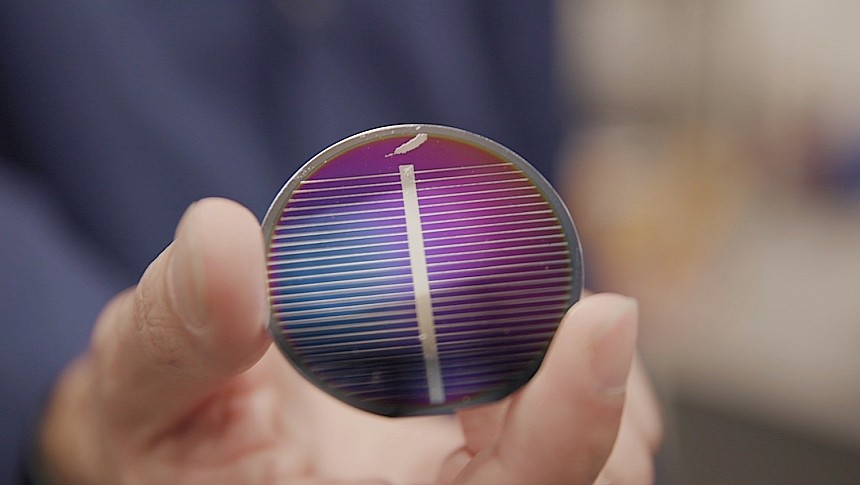With the eyes of humanity set on the Moon as the first alien body that should be colonized by our species in the not-so-distant future, companies and agencies all over the world are presently racing to develop the many supporting technologies that will be required for operations up there. Among them is something called Blue Alchemist.
The fancy name was chosen by Jeff Bezos' Blue Origin to describe a tech like no other. Presented earlier this year, the tech is nothing more than a path to transforming moondust into solar cells and transmission wires which in turn can be used for power generation.
The way Blue Alchemist works is simple, really. One just has to stick some lunar regolith inside a reactor (this one is a bit of a mystery at the moment, as Blue Origin hasn't detailed it yet), and burn it at 1,600 degrees Celsius (2,912 degrees Fahrenheit).
Adding electrolysis to the process, the regolith is broken down into its component parts, meaning stuff like iron, silicon, and aluminum. The only byproduct of the process is oxygen, another element that will be in high demand on the Moon.
It's the silicon that's of interest to Blue Origin though, as it can be used to make solar cells. Through Blue Alchemist, the silicon that was produced had a purity of 99.999 percent, making it ideal for use in solar panels.
Naturally, the space company hasn't tested the idea yet on real regolith, but using simulants. "Chemically and mineralogically equivalent to lunar regolith," these materials do however preview with a high degree of accuracy how the real stuff will behave when subjected to this transformation.
Once the silicon is extracted, a fabrication process that's yet to be detailed is used to make solar cells that should be capable of withstanding the satellite's harsh conditions for up to ten years.
Because it only needs a minimum of equipment to be sent up there and locally-sourced materials, the Blue Alchemist could prove to be a revolutionary idea. NASA certainly seems to think so, and last week awarded Blue Origin Tipping Point funding worth $35 million.
Through Tipping Point NASA picks a piece of tech or a process that, if transformed into a commercial solution, might help advance its space exploration goals. Naturally, easy access to solar panels tech is on that list.
When it was first presented the Blue Alchemist Blue Origin did not say how long it'll take until the tech is ready for more large-scale tests. After the NASA award though, the company said it should be ready to conduct "a demonstration of autonomous operation in a simulated lunar environment by 2026." It remains unclear when an actual mission to the Moon will happen.
The way Blue Alchemist works is simple, really. One just has to stick some lunar regolith inside a reactor (this one is a bit of a mystery at the moment, as Blue Origin hasn't detailed it yet), and burn it at 1,600 degrees Celsius (2,912 degrees Fahrenheit).
Adding electrolysis to the process, the regolith is broken down into its component parts, meaning stuff like iron, silicon, and aluminum. The only byproduct of the process is oxygen, another element that will be in high demand on the Moon.
It's the silicon that's of interest to Blue Origin though, as it can be used to make solar cells. Through Blue Alchemist, the silicon that was produced had a purity of 99.999 percent, making it ideal for use in solar panels.
Naturally, the space company hasn't tested the idea yet on real regolith, but using simulants. "Chemically and mineralogically equivalent to lunar regolith," these materials do however preview with a high degree of accuracy how the real stuff will behave when subjected to this transformation.
Once the silicon is extracted, a fabrication process that's yet to be detailed is used to make solar cells that should be capable of withstanding the satellite's harsh conditions for up to ten years.
Because it only needs a minimum of equipment to be sent up there and locally-sourced materials, the Blue Alchemist could prove to be a revolutionary idea. NASA certainly seems to think so, and last week awarded Blue Origin Tipping Point funding worth $35 million.
Through Tipping Point NASA picks a piece of tech or a process that, if transformed into a commercial solution, might help advance its space exploration goals. Naturally, easy access to solar panels tech is on that list.
When it was first presented the Blue Alchemist Blue Origin did not say how long it'll take until the tech is ready for more large-scale tests. After the NASA award though, the company said it should be ready to conduct "a demonstration of autonomous operation in a simulated lunar environment by 2026." It remains unclear when an actual mission to the Moon will happen.














